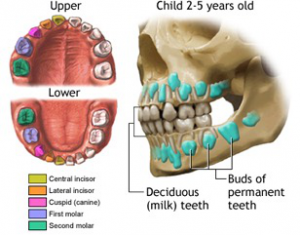There is a common misconception among many people that baby teeth do not matter because they will fall out and the permanent teeth will come in. As a pediatric dentist I will often hear “Why do we have to fix the cavity? Isn’t it just going to fall out?” The answer is YES the tooth will fall out, however, most often decay is occurring in a primary molar, which does not exfoliate until 10-12 years old (see tooth eruption chart below). For example, if your child is five years old the decay will continue to worsen until the tooth cracks or infection and pain develop well before the tooth exfoliates.
Contrary to popular belief primary or baby teeth are important! Primary teeth contribute to a child’s physical, social, and emotional development. Healthy primary teeth allow for proper chewing which fosters good nutrition, aids in speech development, contributes to a healthy self-esteem by allowing a child to smile, enables a child to focus and learn in school without dental pain, as well as, saves space for proper growth and development of the permanent dentition. By changing the views that baby teeth are important it may be possible to change the fact that childhood caries is #1 chronic childhood disease!
Healthy habits should start young. By encouraging your child to brush twice a day and floss daily, you are helping them understand the importance of not only good dental hygiene but overall hygiene as well. Brushing teeth with a toothbrush should begin at the first sign of tooth eruption. However, you can begin taking care of your child’s mouth after birth, by wiping the gums and tongue with a wet washcloth, especially after breastfeeding. Remember to wash the cloth after each daily use. By cleansing the gums of an infant you are reducing the white biofilm that accumulates on the child’s tongue and reducing the bacteria in the mouth for when tooth eruption occurs. You also begin to desensitize your child so they will be more comfortable with tooth brushing in the future. Let’s face it, brushing a child’s teeth can be a difficult task as it is, so beginning early can only help to make it easier, especially if it is part of their routine and something they are already used to.
Don’t let oral hygiene and dental health take a back seat to everything else that you do to keep your children safe and healthy. Establish a relationship with a pediatric dentist by the time your child is ONE so they can answer all your questions and educate you on effective ways to help prevent decay in the primary and permanent teeth.
Lead by example and get your children excited about their oral health. Here are some tips and resources that will aid you and your family:
- Visit the dentist twice a year starting at age 1
- Speak with your children about dental care
- Involve your children in a brushing routine and make it fun
- Use dental apps and activities for brushing & flossing
Apps:
Toothsavers Brushing Game
Brusheez – The Little Monsters Toothbrush Timer
Websites:
Ad Council’s Partnership for Healthy Mouths Healthy Lives: “Brush 2min2x” website – 2 min videos kids can watch while brushing, downloadable app’s http://www.2min2x.org
Sesame Street Workshop: “Healthy Teeth, Healthy Me” website – Game, videos, art, and playlists you’re your children’s favorite characters! http://www.sesamestreet.org/parents/topicsandactivities/toolkits/teeth
